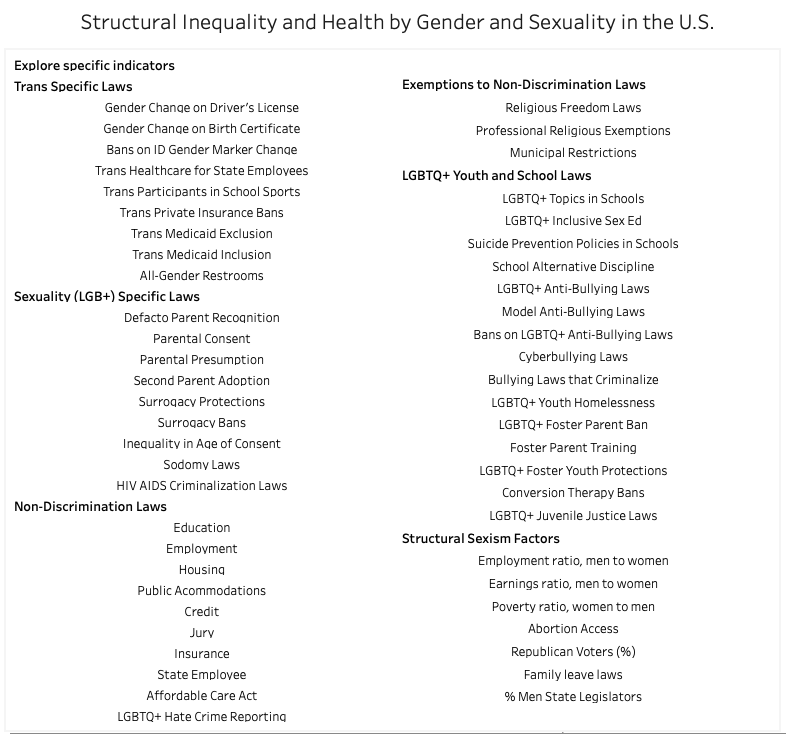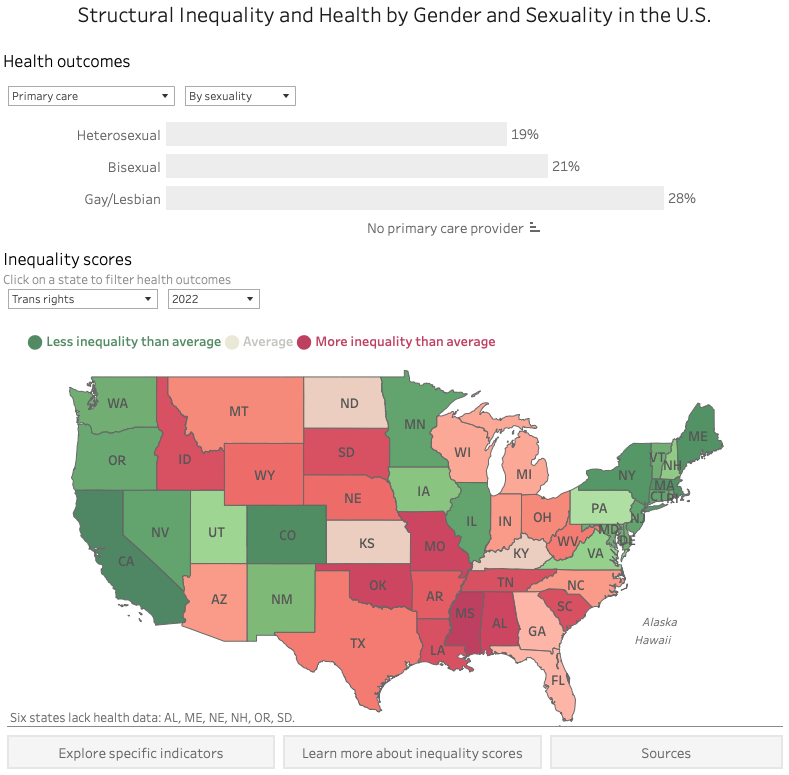Structural Inequality & Health by Gender & Sexuality in the U.S.
Earlier this year, we invited fifteen fellows to develop their own web mapping applications, centered on equity and designed with communities in mind, using the SDOH & Place Toolkit. From July to September, we'll feature final fellow applications each week.
App Motivations
Madeline created this dashboard to connect gender, sexuality, and health in a way that highlighted the importance of state context. Inequality based on gender and sexuality is increasingly different across states in the U.S. For example, in some states, abortion access is restricted, laws make it more difficult for same-sex couples to build families, and transgender people are banned from using public facilities that align with their gender identity. There is growing academic evidence that living in more unequal state contexts is associated with poorer population health outcomes. Madeline's dashboard allows the user to explore these associations – the changes in state context over time, across states, and their associations with mental and physical health outcomes for specific gender and sexuality groups.
The target audience of this dashboard is diverse - it includes researchers, policy makers, students, and individuals who are interested in or personally affected by these state contexts. For instance, LGBTQ+ users might use this dashboard to explore what types of non-discrimination protections are available in their state or users moving to a new state might explore whether health disparities are more pronounced in that state.
Features
The dashboard includes a panel of health data from the Behavioral Risk Factor Surveillance System – a large national health survey that includes information about diverse gender and sexuality.

Bar charts display weighted proportions of five health outcomes (frequent mental distress, 2 or more chronic conditions, one or more functional limitation, lacking a primary care provider, and poor or fair self-rated health) across gender (cisgender women, cisgender men, and transgender adults) and sexuality groups (heterosexual, bisexual, and gay or lesbian adults). Users can toggle between health outcomes by gender and sexuality to change the visualization. The dashboard includes a second panel that allows users to explore three structural inequality scores – transgender rights, gay rights, and structural sexism – displayed on a map of the United States. The first scores capture legal inequality where higher scores indicate more inequality in the laws and policies governing transgender and gay rights. The structural sexism scale captures systematic inequality in power and resources between (presumably mostly cisgender) men and women across economic, legal, and cultural domains. Higher scores indicate more inequality between men and women. The dashboard also includes a menu of specific indicators, those individual laws, policies, or measures of inequality that are used to calculate structural inequality scores. Users can use this menu to navigate to supplemental maps displaying how the presence of various laws or measures of inequality vary across states and over time.

Clicking on a specific state on the structural inequality map will filter the health data to display health information for only that state. There are some interesting associations between high-inequality states and poorer health outcomes for sexual and gender minorities. However, this is not a universal pattern, suggesting that there are other important structural factors at play here.
Upcoming Features
The dashboard is complete and functional. However, analyses of the best way to capture structural inequality are ongoing. Madeline expects to complete these analyses by the end of 2024 and may update the dashboard in 2025 to display new measures of structural inequality.
Check out the application here.
About the Author
Madeline Smith-Johnson is a Ph.D. candidate in the Department of Sociology at Rice University, where they pilot research projects examining the health and social relationships of transgender adults in the United States. They hold a Master of Philosophy in Sociology from the University of Cambridge and a Master of Arts in Sociology from Rice University. Madeline is committed to building comprehensive and creative measures of multilevel gendered stigma to specify stigmas' impact on population health. Their research interests include LGBTQ+ population health, structural sexism, the relationship between state policies and health disparities, healthcare access and delivery, survey measurement of LGBTQ+ identity, and data visualization.












